seat adjustment MAZDA MODEL 3 4-DOOR 2016 Owners Manual
[x] Cancel search | Manufacturer: MAZDA, Model Year: 2016, Model line: MODEL 3 4-DOOR, Model: MAZDA MODEL 3 4-DOOR 2016Pages: 598, PDF Size: 30.13 MB
Page 18 of 598
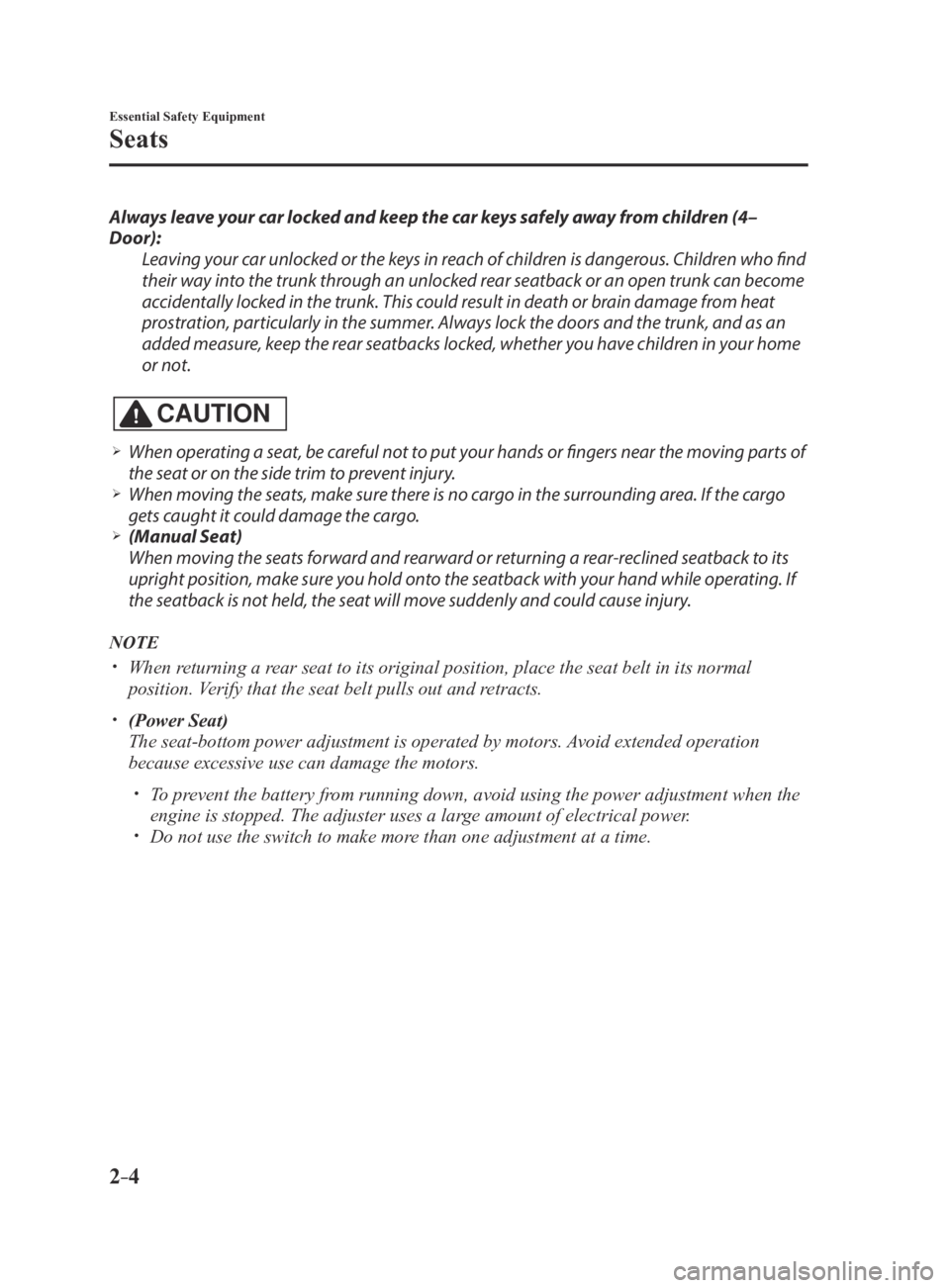
2–4
Essential Safety Equipment
Seats
Always leave your car locked and keep the car keys safely away from children (4–
Door):Leaving your car unlocked or the keys in reach of children is dangerous. Children who find
their way into the trunk through an unlocked rear seatback or an open trunk can become
accidentally locked in the trunk. This could result in death or brain damage from heat
prostration, particularly in the summer. Always lock the doors and the trunk, and as an
added measure, keep the rear seatbacks locked, whether you have children in your home
or not.
CAUTION
When operating a seat, be careful not to put your hands or fingers near the moving parts of
the seat or on the side trim to prevent injury. When moving the seats, make sure there is no cargo in the surrounding area. If the cargo
gets caught it could damage the cargo. (Manual Seat)
When moving the seats forward and rearward or returning a rear-reclined seatback to its
upright position, make sure you hold onto the seatback with your hand while operating. If
the seatback is not held, the seat will move suddenly and could cause injury.
NOTE
When returning a rear seat to its original position, place the seat belt in its normal
position. Verify that the seat belt pulls out and retracts.
(Power Seat)
The seat-bottom power adjustment is operated by motors. Avoid extended operation
because excessive use can damage the motors.
To prevent the battery from running down, avoid using the power adjustment when the
engine is stopped. The adjuster uses a large amount of electrical power. Do not use the switch to make more than one adjustment at a time.
Mazda3_8FA4-EA-15G_Edition3.indb 42015/12/04 19:21:41
Page 19 of 598
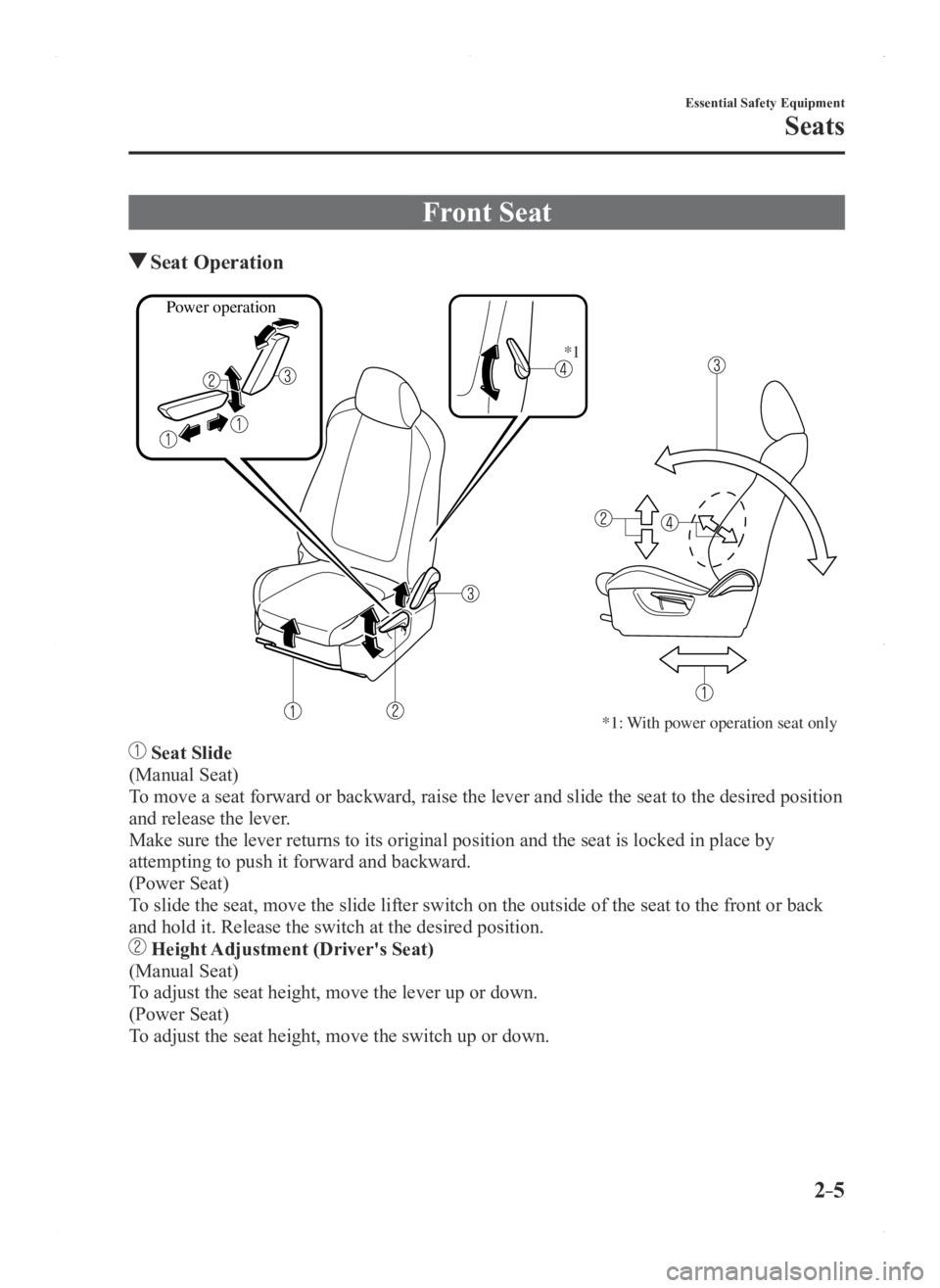
2–5
Essential Safety Equipment
Seats
Front Seat
Seat Operation
*1: With power operation seat only
Power operation*1
Seat Slide
(Manual Seat)
To move a seat forward or backward, raise the lever and slide the seat to\
the desired position
and release the lever.
Make sure the lever returns to its original position and the seat is loc\
ked in place by
attempting to push it forward and backward.
(Power Seat)
To slide the seat, move the slide lifter switch on the outside of the sea\
t to the front or back
and hold it. Release the switch at the desired position.
Height Adjustment (Driver's Seat)
(Manual Seat)
To adjust the seat height, move the lever up or down.
(Power Seat)
To adjust the seat height, move the switch up or down.
Mazda3_8FA4-EA-15G_Edition1.indb 52015/05/11 14:00:00
Page 20 of 598
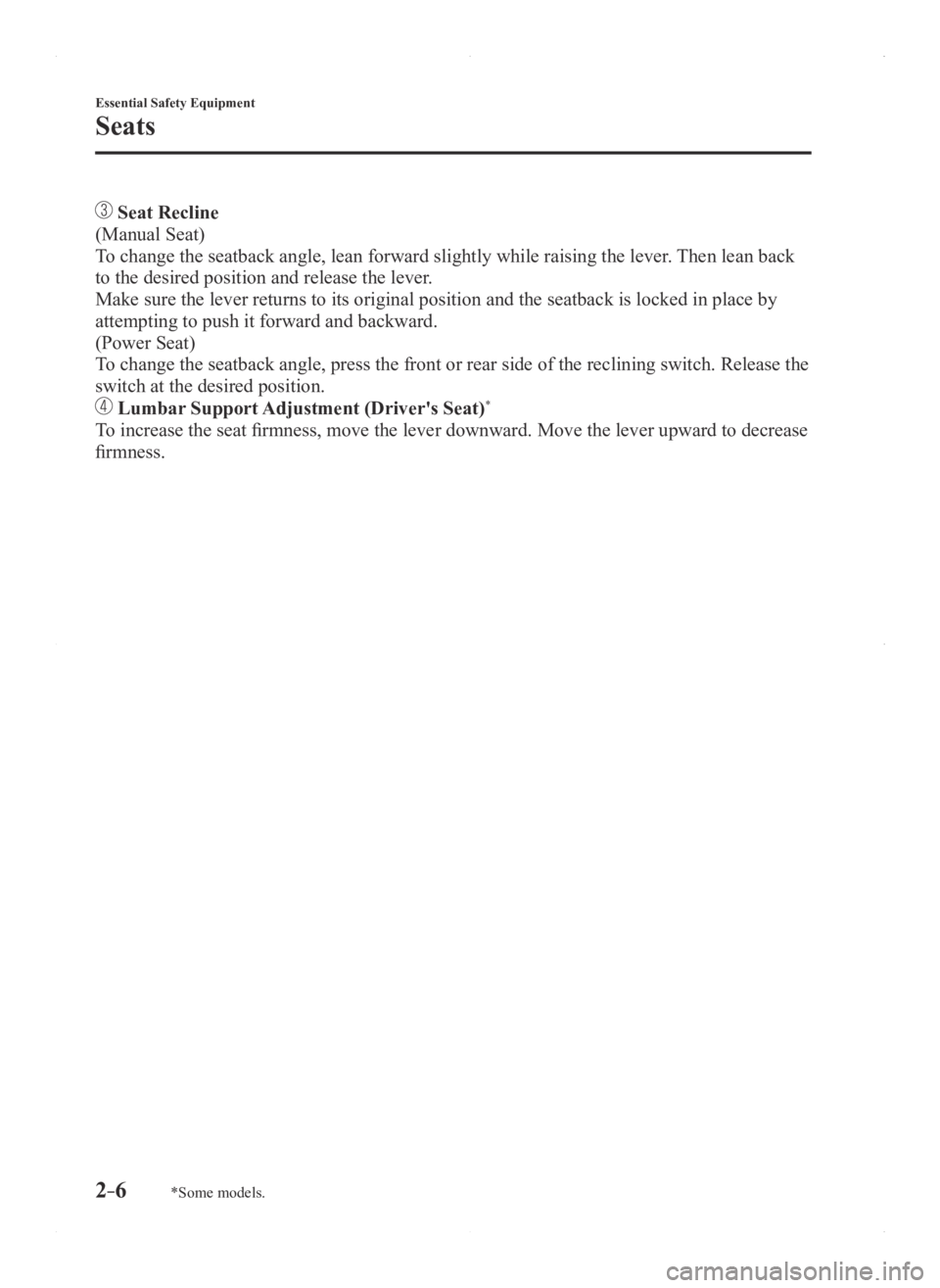
2–6
Essential Safety Equipment
Seats
*Some models.
Seat Recline
(Manual Seat)
To change the seatback angle, lean forward slightly while raising the lev\
er. Then lean back
to the desired position and release the lever.
Make sure the lever returns to its original position and the seatback is\
locked in place by
attempting to push it forward and backward.
(Power Seat)
To change the seatback angle, press the front or rear side of the reclining switch. Release the
switch at the desired position.
Lumbar Support Adjustment (Driver's Seat)*
To increase the seat firmness, move the lever downward. Move the lever upward to decrease
firmness.
Mazda3_8FA4-EA-15G_Edition1.indb 62015/05/11 14:00:00
Page 25 of 598

2–11
Essential Safety Equipment
Seats
*Some models.
Head Restraints
Your vehicle is equipped with head
restraints on all outboard seats and the
rear center seat
*. The head restraints
are intended to help protect you and the
passengers from neck injury.
WARNING
Always drive with the head restraints
installed when seats are being used and
make sure they are properly adjusted: Driving with the head restraints
adjusted too low or removed is
dangerous. With no support behind
your head, your neck could be seriously
injured in a collision.
Height adjustment
To raise a head restraint, pull it up to the
desired position.
To lower the head restraint, press the stop-
catch release, then push the head restraint
down.
Adjust the head restraint so that the center
is even with the top of the passenger's ears.
Front outboard seat
Rear outboard seat
Rear center seat*
Mazda3_8FA4-EA-15G_Edition1.indb 112015/05/11 14:00:03
Page 27 of 598
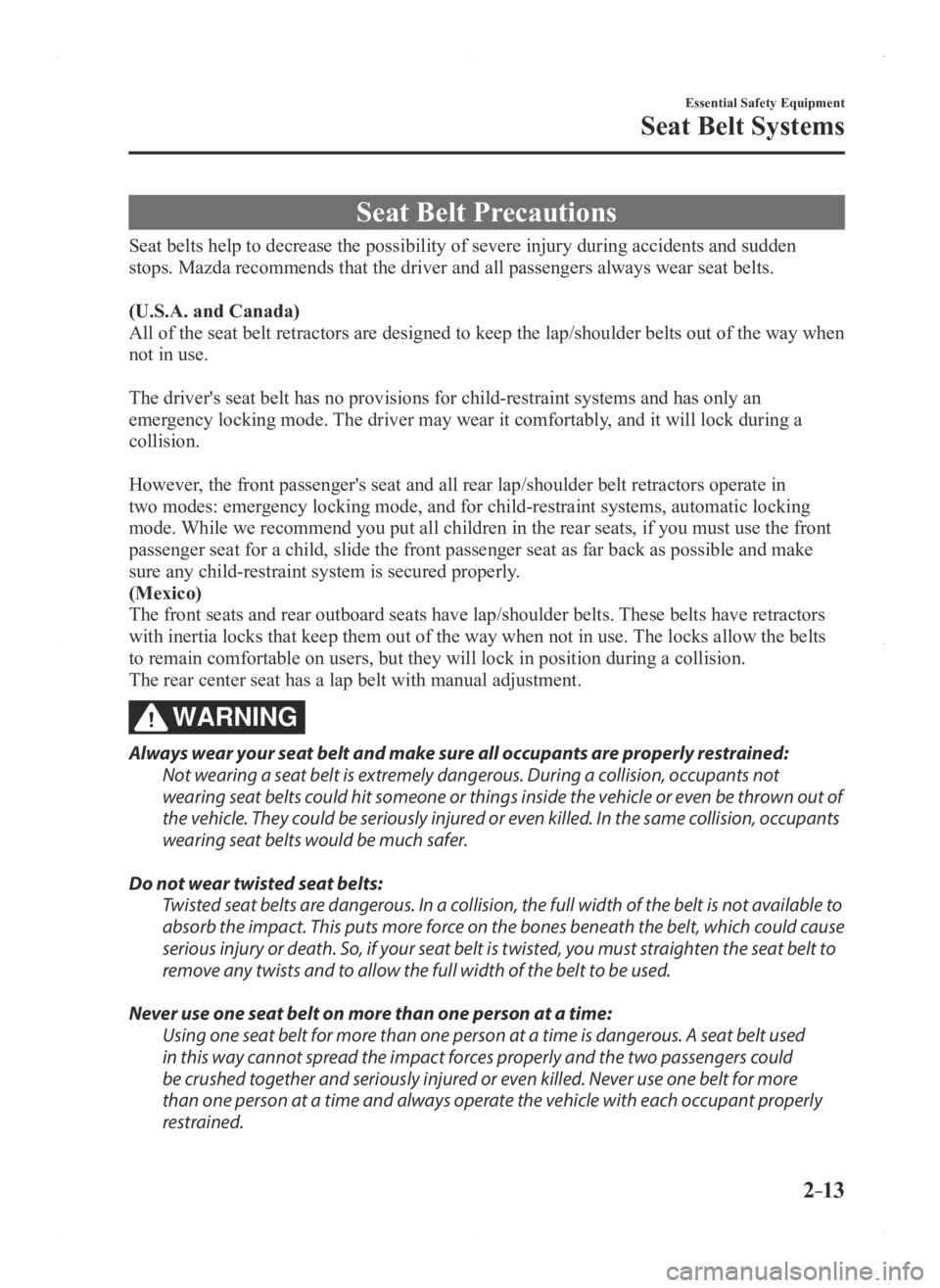
2–13
Essential Safety Equipment
Seat Belt Systems
Seat Belt Precautions
Seat belts help to decrease the possibility of severe injury during acci\
dents and sudden
stops. Mazda recommends that the driver and all passengers always wear s\
eat belts.
(U.S.A. and Canada)
All of the seat belt retractors are designed to keep the lap/shoulder be\
lts out of the way when
not in use.
The driver's seat belt has no provisions for child-restraint systems and\
has only an
emergency locking mode. The driver may wear it comfortably, and it will lock during a
collision.
However, the front passenger's seat and all rear lap/shoulder belt retractors o\
perate in
two modes: emergency locking mode, and for child-restraint systems, automatic locking
mode. While we recommend you put all children in the rear seats, if you must u\
se the front
passenger seat for a child, slide the front passenger seat as far back a\
s possible and make
sure any child-restraint system is secured properly.
(Mexico)
The front seats and rear outboard seats have lap/shoulder belts. These belts have retractors
with inertia locks that keep them out of the way when not in use. The locks allow the belts
to remain comfortable on users, but they will lock in position during a \
collision.
The rear center seat has a lap belt with manual adjustment.
WARNING
Always wear your seat belt and make sure all occupants are properly restrained:
Not wearing a seat belt is extremely dangerous. During a collision, occupants not
wearing seat belts could hit someone or things inside the vehicle or even be thrown out of
the vehicle. They could be seriously injured or even killed. In the same collision, occupants
wearing seat belts would be much safer.
Do not wear twisted seat belts: Twisted seat belts are dangerous. In a collision, the full width of the belt is not available to
absorb the impact. This puts more force on the bones beneath the belt, which could cause
serious injury or death. So, if your seat belt is twisted, you must straighten the seat belt to
remove any twists and to allow the full width of the belt to be used.
Never use one seat belt on more than one person at a time: Using one seat belt for more than one person at a time is dangerous. A seat belt used
in this way cannot spread the impact forces properly and the two passengers could
be crushed together and seriously injured or even killed. Never use one belt for more
than one person at a time and always operate the vehicle with each occupant properly
restrained.
Mazda3_8FA4-EA-15G_Edition1.indb 132015/05/11 14:00:03
Page 109 of 598
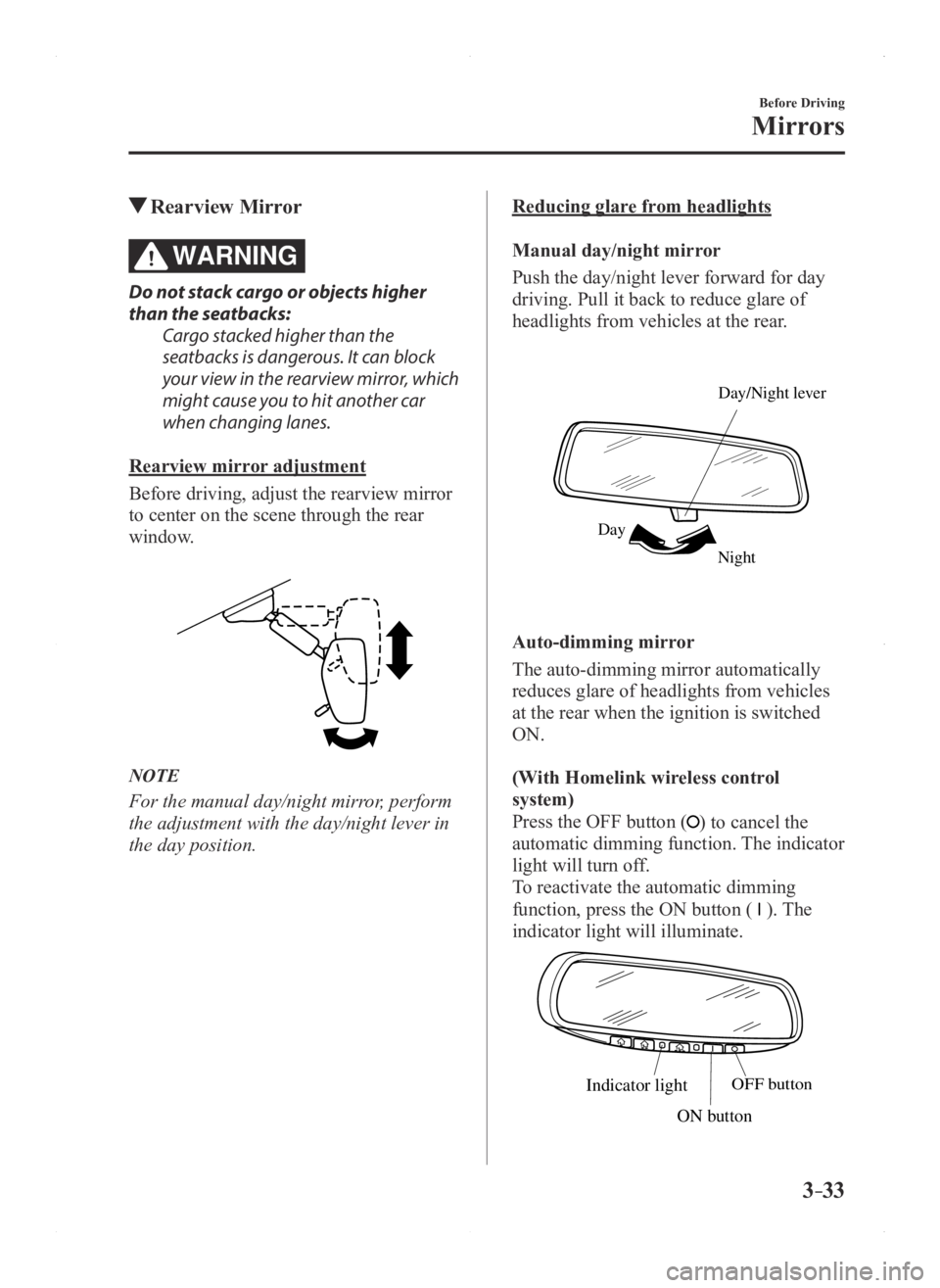
3–33
Before Driving
Mirrors
Rearview Mirror
WARNING
Do not stack cargo or objects higher
than the seatbacks: Cargo stacked higher than the
seatbacks is dangerous. It can block
your view in the rearview mirror, which
might cause you to hit another car
when changing lanes.
Rearview mirror adjustment
Before driving, adjust the rearview mirror
to center on the scene through the rear
window.
NOTE
For the manual day/night mirror, perform
the adjustment with the day/night lever in
the day position.
Reducing glare from headlights
Manual day/night mirror
Push the day/night lever forward for day
driving. Pull it back to reduce glare of
headlights from vehicles at the rear.
Night
Day Day/Night le
ver
Auto-dimming mirror
The auto-dimming mirror automatically
reduces glare of headlights from vehicles
at the rear when the ignition is switched
ON.
(With Homelink wireless control
system)
Press the OFF button (
) to cancel the
automatic dimming function. The indicator
light will turn off.
To reactivate the automatic dimming
function, press the ON button (
). The
indicator light will illuminate.
Indicator lightOFF button
ON button
Mazda3_8FA4-EA-15G_Edition1.indb 332015/05/11 14:00:26
Page 596 of 598
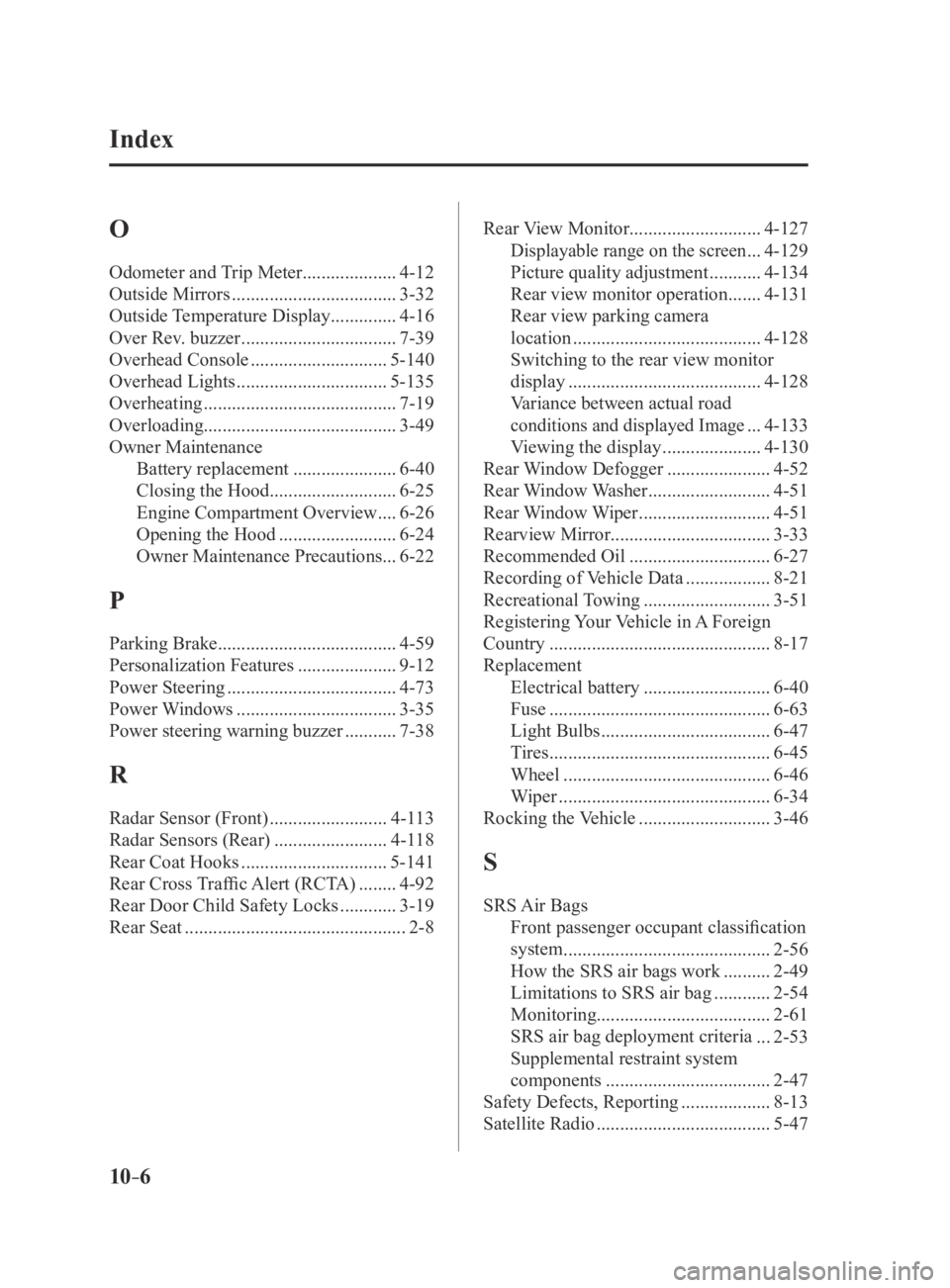
10–6
Index
O
Odometer and Trip Meter ....................4-12
Outside Mirrors
...................................3-32
Outside Temperature Display
..............4-16
Over Rev. buzzer
.................................7-39
Overhead Console
.............................5-140
Overhead Lights
................................5-135
Overheating
.........................................7-19
Overloading
.........................................3-49
Owner Maintenance Battery replacement
......................6-40
Closing the Hood ...........................6-25
Engine Compartment Overview
....6-26
Opening the Hood
.........................6-24
Owner Maintenance Precautions ...6-22
P
Parking Brake ......................................4-59
Personalization Features
.....................9-12
Power Steering
....................................4-73
Power Windows
..................................3-35
Power steering warning buzzer
...........7-38
R
Radar Sensor (Front) .........................4-113
Radar Sensors (Rear)
........................4-118
Rear Coat Hooks
...............................5-141
Rear Cross Traffic Alert (RCTA)
........4-92
Rear Door Child Safety Locks
............3-19
Rear Seat
...............................................2-8 Rear View Monitor
............................4-127
Displayable range on the screen ...4-129
Picture quality adjustment
...........4-134
Rear view monitor operation
.......4-131
Rear view parking camera
location
........................................4-128
Switching to the rear view monitor
display
.........................................4-128
Variance between actual road
conditions and displayed Image ...4-133
Viewing the display
.....................4-130
Rear Window Defogger
......................4-52
Rear Window Washer
..........................4-51
Rear Window Wiper
............................4-51
Rearview Mirror
..................................3-33
Recommended Oil
..............................6-27
Recording of Vehicle Data
..................8-21
Recreational Towing
...........................3-51
Registering Your Vehicle in A Foreign
Country
...............................................8-17
Replacement Electrical battery
...........................6-40
Fuse
...............................................6-63
Light Bulbs
....................................6-47
Tires
...............................................6-45
Wheel
............................................6-46
Wiper
.............................................6-34
Rocking the Vehicle
............................3-46
S
SRS Air Bags Front passenger occupant classification
system
............................................2-56
How the SRS air bags work
..........2-49
Limitations to SRS air bag
............2-54
Monitoring ..................................... 2-61
SRS air bag deployment criteria
...2-53
Supplemental restraint system
components
...................................2-47
Safety Defects, Reporting
...................8-13
Satellite Radio
.....................................5-47
Mazda3_8FA4-EA-15G_Edition3.indb 62015/12/04 19:26:20